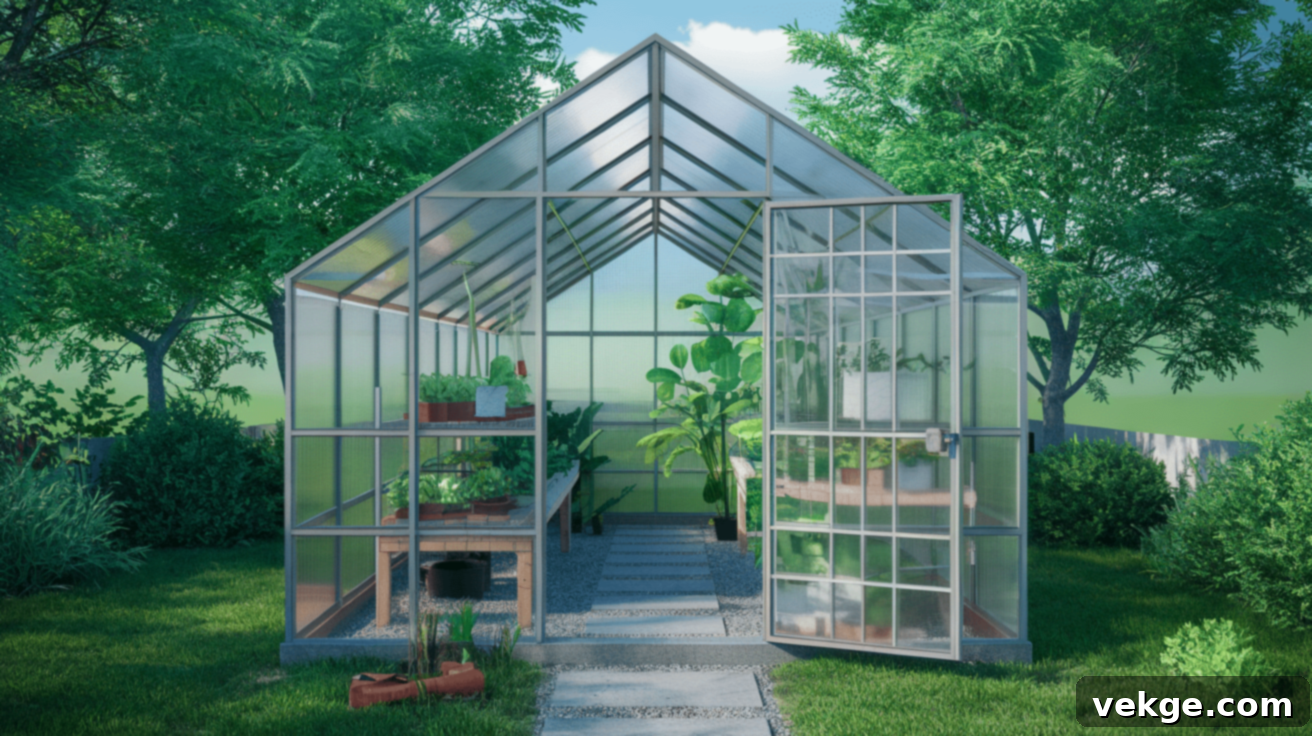Ultimate Guide to Setting Up Your Dream Greenhouse: Planning, Layout, and Maximizing Your Grow Space
Establishing your own greenhouse opens up an exciting world of possibilities for cultivating a diverse range of plants throughout the year, regardless of external weather conditions. This comprehensive guide is designed to walk you through every essential step, from the initial planning stages to the final setup, ensuring your greenhouse perfectly aligns with your horticultural aspirations and spatial requirements.
We’ll delve into all critical aspects of greenhouse ownership and management. This includes meticulously planning how you’ll utilize your space, designing an efficient layout, exploring various growing methods, selecting and implementing effective watering systems, and optimizing storage solutions. Our aim is to equip you with the knowledge to avoid common pitfalls and create a highly productive and enjoyable growing environment.
Discover innovative strategies for organizing your plants, implementing automated systems, and even carving out a serene spot for relaxation amidst your flourishing greenery. Learn practical tips for maximizing every square inch, especially beneficial for those with smaller greenhouses. By following these expert recommendations, you’ll be well on your way to creating a successful and sustainable growing sanctuary that thrives in every season.
Decide How You’ll Use Your Greenhouse
Before investing in a greenhouse, it’s crucial to define its primary purpose. This fundamental decision will heavily influence your choices regarding size, materials, heating requirements, and overall design. Consider the following popular applications:
- Year-Round Vegetable Production: Imagine harvesting fresh, homegrown tomatoes in the dead of winter or enjoying crisp lettuce weeks before the outdoor growing season begins. A greenhouse makes continuous vegetable cultivation a reality, providing a consistent supply of organic produce for your kitchen.
- Growing Exotic Fruits and Flowers: Many enthusiasts use greenhouses to cultivate fruit trees in pots, such as citrus or figs, that require extra warmth and protection from frost. Similarly, delicate or tropical flowers that struggle in temperate climates can flourish year-round, adding vibrant color and fragrance to your home.
- Protecting Tropical and Sensitive Plants: If you own tropical houseplants or other sensitive specimens, a greenhouse acts as a vital sanctuary during colder months, shielding them from harsh temperatures and low humidity. It provides a stable, controlled environment essential for their survival and growth.
- A Serene Retreat and Relaxation Zone: Beyond its utilitarian function, a greenhouse can be transformed into a tranquil oasis. Many owners integrate a small seating area, complete with comfortable chairs or a bench, creating a peaceful spot to unwind, read, or simply enjoy the calming presence of their plants.
- Hybrid Uses: For many, a combination of these uses proves most effective. You might dedicate one section to growing food, another to propagating seedlings, and a third to displaying special plants or a quiet sitting area. Your main goal and available space will guide you in prioritizing these diverse functions.
Clearly defining your primary use cases from the outset will simplify subsequent decisions regarding the appropriate size, style, and features of your ideal greenhouse.
Basics of Greenhouse Layout and Design
An efficient greenhouse layout is fundamental to successful plant growth and ease of maintenance. Strategic planning ensures optimal light distribution, airflow, and accessibility.
Plan for Sunlight and Shade
Understanding sun exposure is paramount for plant health. Position taller plants, which naturally cast more shadow, on the north side of your greenhouse. This prevents them from obstructing vital light to smaller plants positioned further south. South-facing areas receive the most intense and prolonged sunlight, making them ideal for sun-loving plants like tomatoes, peppers, and most flowering varieties.
Conversely, create designated shade spots for plants that prefer less direct light, such as ferns, orchids, or certain herbs. This can be achieved using movable shade cloths, which are particularly useful during the intense summer months. Remember to account for seasonal variations: the winter sun’s angle is much lower than in summer, meaning light penetrates deeper and differently into the greenhouse. Adjusting plant positions or shading as the seasons change can significantly impact plant vigor.
Leave Room for Movement and Airflow
Efficient movement within your greenhouse is crucial for daily tasks. Design paths that are at least 2 feet (approximately 60 cm) wide. This allows you to comfortably navigate with watering cans, tools, wheelbarrows, and even larger pots without bumping into plants or equipment. Adequate pathways also reduce the risk of accidental damage to your plants.
Equally important is ensuring sufficient space between plants. Crowding plants together restricts airflow, creating stagnant, humid pockets where fungal diseases, pests, and mold thrive. Good air circulation is vital for transpiration and overall plant health. Keep all doorways, vents, and fan areas completely clear of shelves, hanging baskets, and dense foliage to facilitate maximum air exchange and temperature regulation.
Zone Your Greenhouse for Optimal Growth
Zoning your greenhouse involves grouping plants with similar environmental requirements together. This strategy simplifies care and creates microclimates tailored to specific plant needs:
- Temperature Zones: Place heat-loving plants, such as most tropical varieties or fruiting plants requiring warm conditions, near heaters or in the naturally warmest sections of your greenhouse. Conversely, cooler-loving plants can be situated closer to vents or in areas that tend to be slightly shadier.
- Moisture Zones: Group moisture-loving plants together, ideally close to your primary water source or misting systems. This makes watering more efficient and helps maintain localized humidity levels without affecting drier-loving plants.
- Vertical Zoning: Utilize the vertical space by employing multi-tiered shelving. Remember that heat naturally rises, so the top shelves will generally be warmer and drier, suitable for plants that prefer these conditions. Cooler, more humid air tends to settle at lower levels, which might benefit seedlings or humidity-loving ground cover plants.
- Monitoring: Install multiple thermometers and hygrometers in various areas of your greenhouse to accurately track temperature and humidity zones. This data will help you fine-tune plant placement and environmental controls.
In-Ground vs. Container Growing: Choosing Your Method
Deciding between growing plants directly in the ground or in containers is a key decision that impacts flexibility, maintenance, and plant health. Many greenhouse owners opt for a hybrid approach.
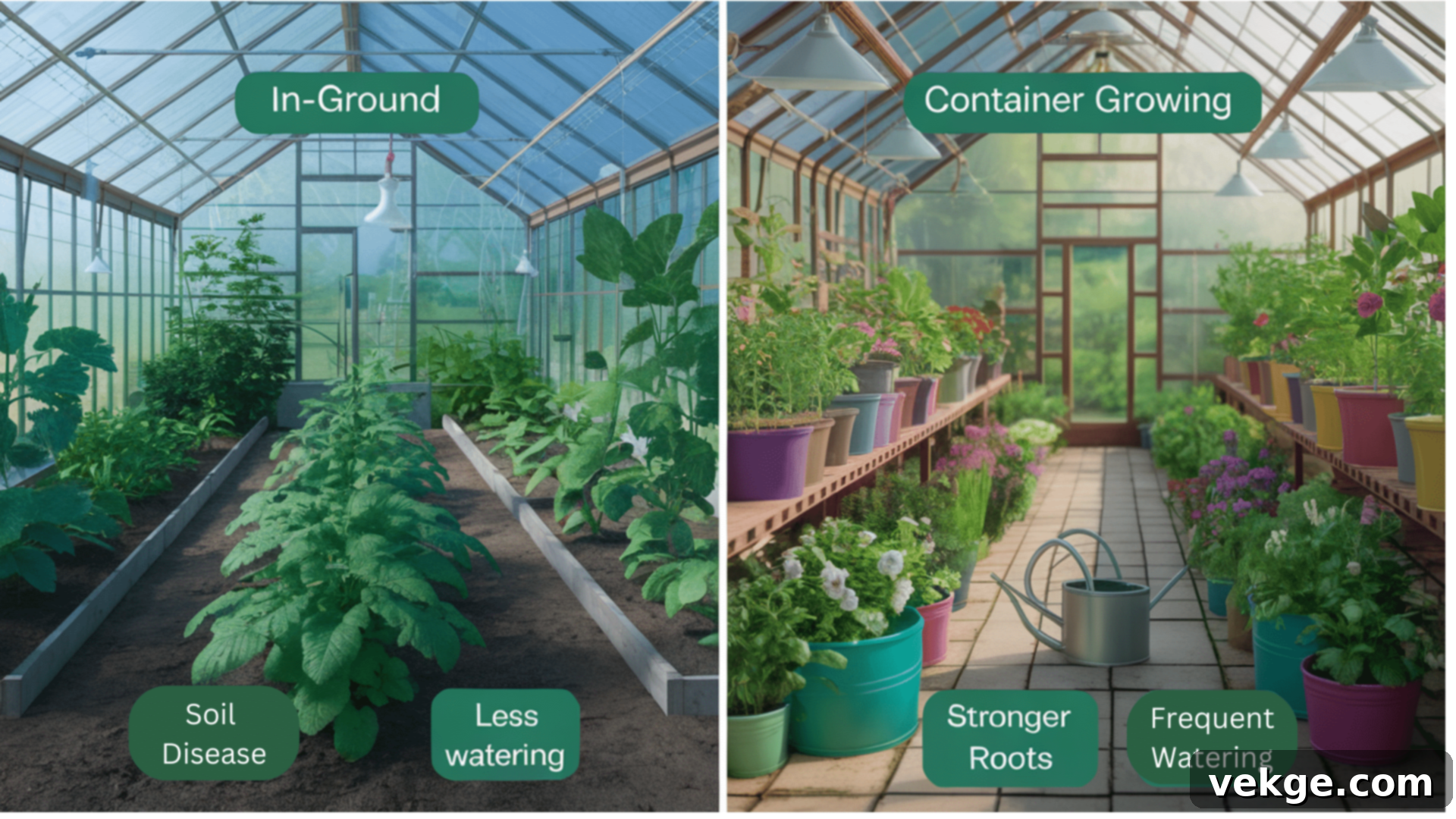
Pros and Cons of Each
In-Ground Growing (Raised Beds or Direct Soil):
- Pros:
- Stronger Root Systems: Plants can develop extensive, deep root networks, leading to more vigorous growth and greater resilience.
- Less Frequent Watering: Larger soil volume retains moisture longer, reducing the need for daily watering.
- Ideal for Large Plants: Provides ample space for large, sprawling plants like indeterminate tomatoes, cucumbers, or small fruit trees.
- Lower Maintenance (Once Established): Requires less daily attention compared to containers, especially regarding watering and feeding.
- More Stable Soil Temperature: The larger mass of soil buffers against rapid temperature fluctuations.
- Nutrient Availability: Plants have access to a broader range of nutrients and beneficial soil microbes.
- Cons:
- Limited Mobility: Once planted, their location is permanent, making layout changes difficult.
- Potential Soil Disease Issues: Diseases can persist in the soil year after year if not properly managed.
- Difficult to Control Soil Quality: Amending large beds can be labor-intensive, and soil borne diseases are harder to isolate.
- Permanent Commitment: Changes to the greenhouse structure or purpose might be complicated.
Container Growing:
- Pros:
- Movable Plants: Offers immense flexibility to rearrange plants for optimal light, temperature, or to bring them indoors.
- Easier to Control Soil Mix: You can create custom soil blends for specific plant needs (e.g., acidic soil for blueberries, sandy soil for succulents).
- Grow More Varieties: Allows you to grow a wider array of plants, each in its ideal soil and microclimate.
- Simple to Replace Sick Plants: Isolating and replacing diseased plants is straightforward, preventing spread.
- Adjustable Height: Use stands or shelves to raise plants to a comfortable working height, reducing back strain.
- Better Pest Management: Easier to inspect and treat individual plants for pests.
- Cons:
- Requires More Frequent Watering: Smaller soil volume dries out quickly, often necessitating daily or twice-daily watering, especially in warm weather.
- Limited Root Space: Can restrict the growth of larger plants, potentially leading to them becoming “root-bound.”
- Higher Pot Cost: Initial investment in quality pots can be significant.
- Faster Nutrient Depletion: Nutrients leach out more quickly, requiring more frequent feeding.
- Soil Dries Out Faster: Risk of underwatering is higher if not monitored diligently.
When to Choose One Over the Other
Opt for in-ground beds or raised beds for long-term, established plants that require ample root space, such as tomatoes, cucumbers, peppers, or perennial herbs. These are best suited for larger greenhouses where space is less of a constraint.
Choose containers for plants you might want to move seasonally, such as herbs you bring indoors for cooking, flowering annuals, or specialty plants that require unique growing conditions. Containers are ideal for small greenhouses where flexibility and adaptability are key, allowing you to easily change your layout or plant selection.
Hybrid Growing Tips for Versatility
A hybrid approach often offers the best of both worlds, combining the stability of in-ground planting with the flexibility of containers:
- Raised Beds for Drainage: Use raised beds for the benefits of in-ground growing (large soil volume, stable temperature) combined with superior drainage and better control over soil composition.
- Strategic Placement: Place permanent, in-ground plants in the center or along the back of your greenhouse, and arrange movable container plants along the edges or in front.
- Climbers In-Ground, Annuals in Pots: Grow climbing plants like pole beans or vining cucumbers directly in the ground where they can establish strong roots, while short-lived annuals or experimental crops can go in containers.
- Special Soil Needs: Utilize containers exclusively for plants that demand specific soil conditions, like acid-loving blueberries or drought-tolerant succulents, making it easy to provide their exact requirements without altering your main beds.
- Fabric Pots: Explore fabric pots as a middle-ground option. They offer excellent aeration and drainage, preventing root circling often seen in plastic pots, and can be moved more easily than in-ground plants.
- Rotate Container Plants: Regularly rotate container plants to ensure all sides receive equal sun exposure, promoting even growth and preventing leaning.
- Utilize Vertical Growing: Combine containers with vertical growing systems on walls or trellises to maximize space in both growing methods.
Watering System Options for Your Greenhouse
Efficient watering is crucial for plant health in a greenhouse. Your choice of watering method should align with your plants’ specific needs, the size of your greenhouse, and your availability to attend to them.
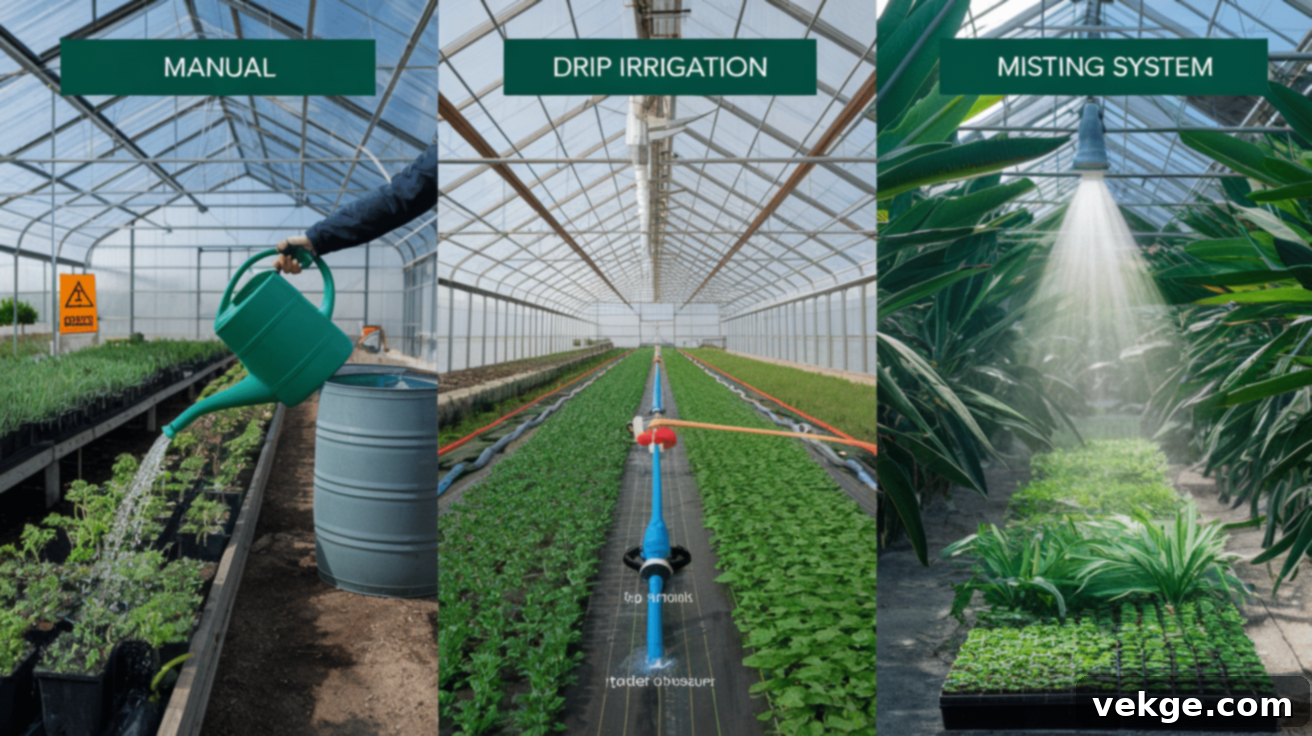
Manual Watering Tips
Manual watering offers direct control and allows you to inspect plants closely. Always water thoroughly in the morning; this allows foliage to dry before evening, significantly reducing the risk of fungal diseases. Use a watering can with a narrow spout for precise watering of individual containers, directing water exactly where it’s needed at the soil level. For delicate seedlings or broad areas, a rose attachment on your watering can or hose provides a gentle, even spray that won’t disturb young plants or compact the soil.
Before watering, always check the soil moisture. Insert your finger about an inch into the soil; only water if it feels dry. Overwatering is a common mistake and can lead to root rot. Consider collecting rainwater in barrels; rainwater is free of chlorine and other chemicals found in tap water, making it healthier for your plants and more environmentally friendly.
Setting Up Drip Irrigation for Efficiency
Drip irrigation systems are an excellent choice for consistent and water-efficient watering, especially for greenhouses of all sizes. They deliver water directly to the plant’s root zone, minimizing evaporation and runoff. The setup involves connecting flexible tubing to a water source, then running smaller feeder lines to each plant. Emitters or drippers are then installed at the base of each plant.
Integrating a timer allows for automatic watering, ensuring your plants receive consistent moisture even when you’re away. Add pressure regulators to your system to maintain a steady and even water flow, preventing damage to the system and ensuring all plants receive the same amount of water. Crucially, place drippers directly at the plant bases, avoiding wetting the leaves, which can lead to fungal issues. Start with a simple drip kit and expand it as your greenhouse collection grows or changes.
Using Misting Systems Safely and Effectively
Misting systems are primarily used to increase ambient humidity, which is vital for tropical plants, orchids, and seedlings, and to help cool the greenhouse during hot periods. Install misters high up in the greenhouse, ensuring they point downwards to distribute a fine, even mist over your plants.
Set short misting times, typically just 1-2 minutes, repeated several times daily rather than one long burst. This prevents over-saturation and creates a more natural humid environment. Safety is paramount: ensure all electrical components, such as timers and pumps, are kept well away from water spray and are rated for outdoor or damp environments. Regular maintenance is key; clean nozzles monthly to prevent clogging from mineral deposits, which can lead to uneven spray patterns. Misters are most beneficial for specific high-humidity plant zones and not typically for all plants in the greenhouse.
Establishing a Productive Seed Starting Station
A dedicated seed starting station is invaluable for cultivating healthy seedlings, giving your plants a strong head start before transplanting. It allows you to extend your growing season and experiment with a wider variety of plants.
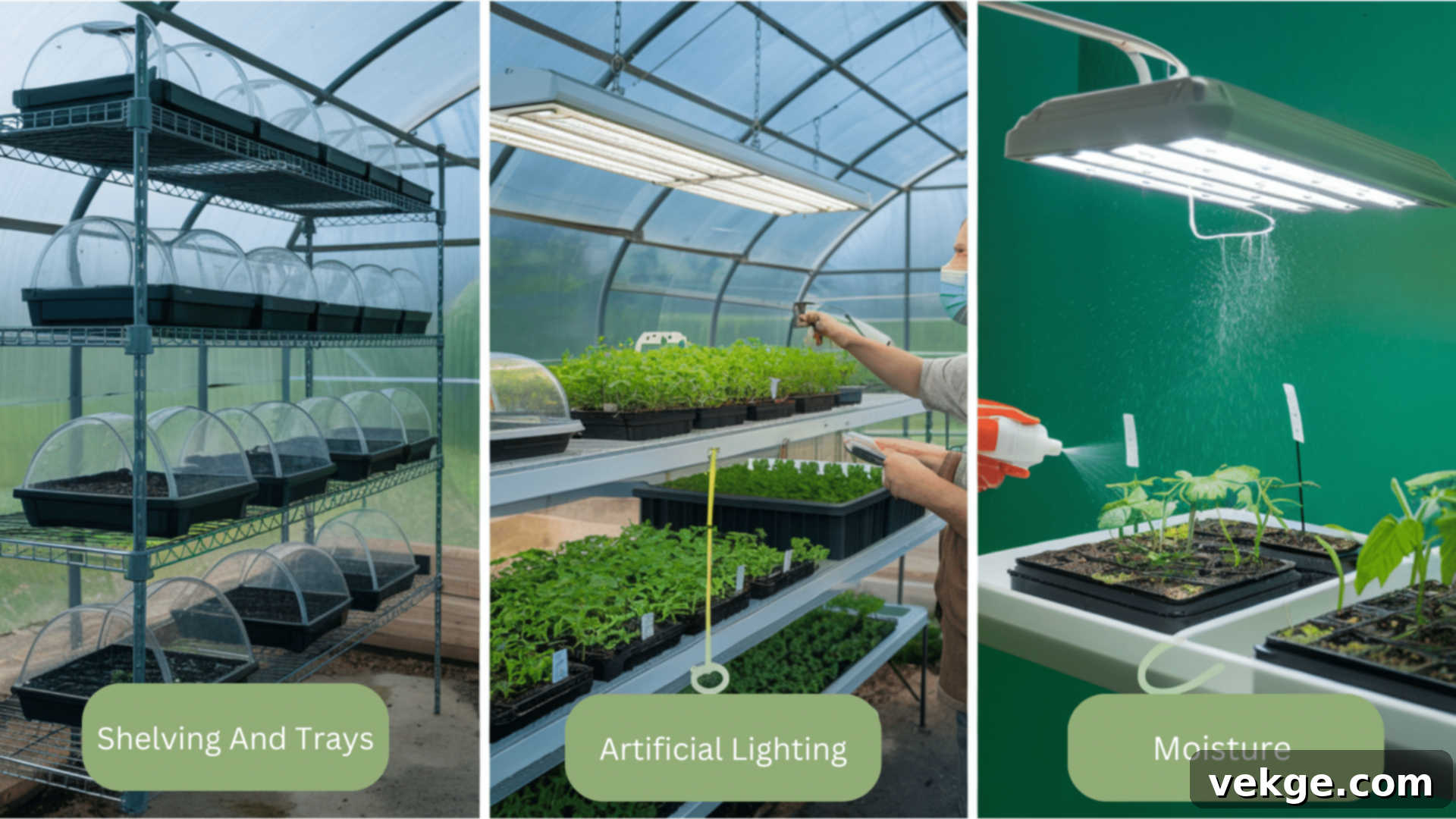
Shelving and Trays for Organization
Choose robust shelving that can comfortably bear the considerable weight of wet soil and numerous trays. Multi-level wire shelving is highly recommended because its open design allows maximum light penetration to all levels, essential for uniform growth. Opt for seed starting trays that feature adequate drainage holes to prevent waterlogging, and pair them with matching water-catch trays to protect surfaces and collect excess water for bottom watering.
Clear plastic dome covers are excellent for creating a mini-greenhouse effect, trapping moisture and warmth to accelerate seed germination. Always label each tray clearly with the plant names, varieties, and planting dates to avoid confusion as your seedlings grow. Ensure all flat surfaces in your station are easy to clean and disinfect regularly; this practice is crucial for preventing the spread of plant diseases and damping-off, a common killer of young seedlings.
Artificial vs. Natural Lighting for Seedlings
While natural sunlight is ideal during spring and summer, it’s often insufficient during shorter winter days or prolonged cloudy periods, especially for vigorous seedling growth. Supplement natural light with artificial grow lights positioned 2-4 inches (5-10 cm) above your seedlings for 14-16 hours daily. This ensures they receive adequate light intensity for strong, stocky growth, preventing leggy, weak stems.
LED grow lights are a fantastic choice due to their energy efficiency, long lifespan, and minimal heat output, reducing the risk of scorching delicate leaves. They are also available in various spectrums to suit different growth stages. Fluorescent lights, while less efficient, are also a viable option. Adjustable light fixtures are highly beneficial, allowing you to raise the lights as your seedlings grow taller, maintaining the optimal distance. A balanced approach combining natural sun with artificial grow lights, particularly on overcast days or in the darker winter months, typically yields the best results.
Moisture and Humidity Tips for Germination
Maintaining the correct moisture and humidity levels is paramount for successful seed germination and early seedling development. Keep the soil consistently damp, but never soggy, as excessive moisture can lead to fungal issues and root rot. A fine mist spray bottle is ideal for gentle watering, as it prevents washing away tiny seeds or compacting the delicate seedling soil.
Plastic dome covers play a vital role in trapping moisture and creating a humid environment, which is perfect for germination. However, remove these covers once sprouts appear to improve air circulation and prevent damping-off. Consider bottom-watering by filling the catch tray and allowing the soil to absorb water from below; this encourages roots to grow downwards and keeps the soil surface drier, deterring pests and diseases. To further prevent mold and encourage stronger stems, use a small fan on a very low setting for a few hours daily. Given how quickly seed trays can dry out, check moisture levels daily, especially in a heated greenhouse environment.
Smart Storage and Workspace Tips for an Organized Greenhouse
An organized greenhouse enhances efficiency, reduces stress, and provides a safer working environment. Strategic storage of your tools, supplies, and equipment can significantly improve your gardening experience.
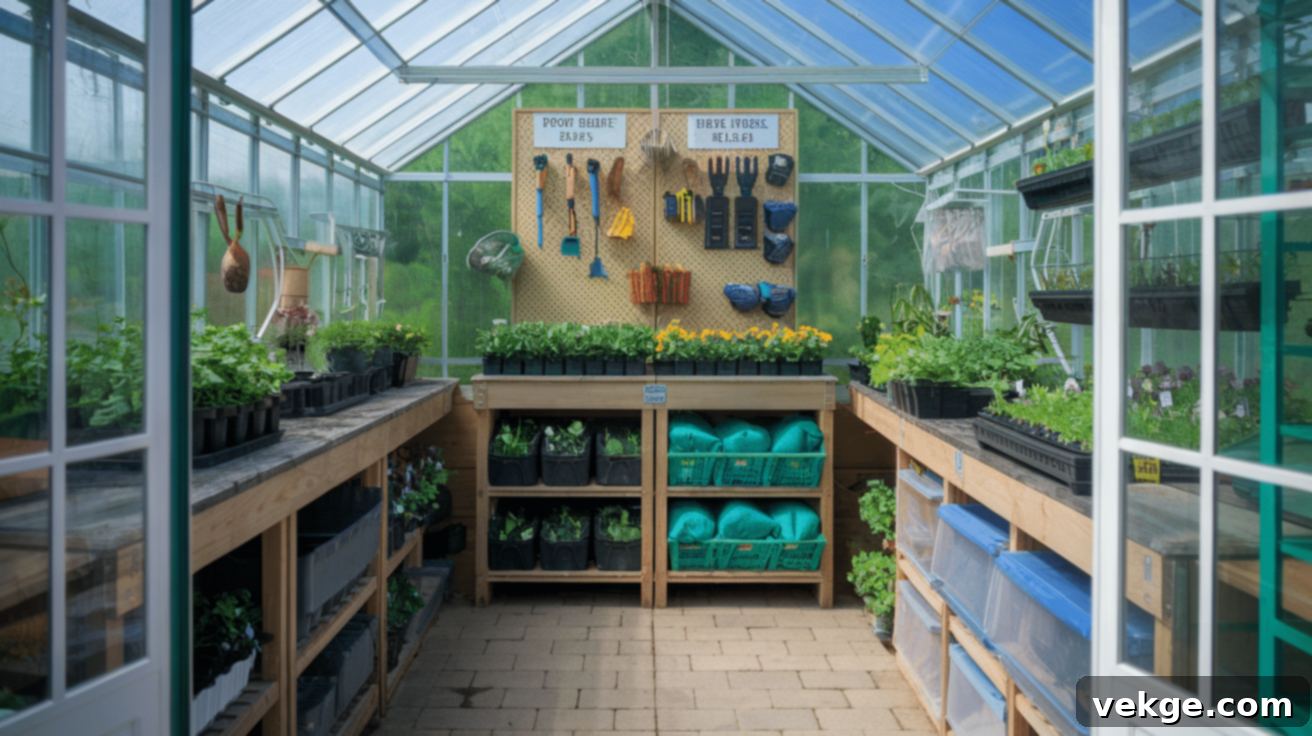
1. Potting Bench Placement for Ergonomics
Strategically place your potting bench near the greenhouse door for quick and easy access when bringing in new supplies or moving plants. Select a location that benefits from good natural light for detailed work but doesn’t occupy prime growing space that could be used for plants requiring full sun. Ensure your potting bench does not obstruct walkways or block access to vents or other essential areas. For optimal ergonomics, the ideal height for your potting bench should be slightly lower than your elbow when standing, which minimizes back strain during prolonged potting sessions.
2. Efficient Tool Storage Options
Maximize floor space and keep tools in excellent condition by hanging them on wall hooks or pegboards. This keeps them dry, prevents rust, and makes them easily visible and accessible. Store smaller items such as plant tags, twist ties, and seed packets in clear, sealed containers to protect them from moisture and pests. Repurpose old kitchen utensil holders or magnetic strips for organizing hand tools like pruners and trowels. A customizable pegboard system allows you to arrange tools based on their frequency of use, keeping the most-used items within arm’s reach.
3. Keeping Things Clean and Dry
Regular cleanliness is paramount for greenhouse hygiene. Clean tools thoroughly after each use; this prevents the spread of plant diseases and extends their lifespan by preventing rust. Sweep greenhouse floors weekly to remove accumulated soil, fallen leaves, and plant debris, which can harbor pests and pathogens. Store bulk bags of growing medium, such as potting soil or compost, in closed, airtight bins to deter pests like rodents and insects. Utilize raised shelves or pallets for storing all bagged goods, keeping them dry and protected from ground moisture, which can lead to mold and degradation.
4. Smart Space Organization Techniques
Efficiently organize your space by stacking pots by size; this saves a significant amount of space. Make full use of vertical wall space by installing hanging organizers, shelves, or even vertical planters for herbs. Place frequently used items at waist level for easy retrieval, while less common items can be stored on higher or lower shelves. Consider investing in fold-down tables or work surfaces that can be neatly tucked away when not in use, instantly freeing up valuable floor space for plant movement or other activities.
5. Seasonal Storage Solutions
Adapt your storage system to seasonal needs. Rotate supplies, storing summer-specific items (like shade cloths or specific fertilizers) during winter months, and bringing winter necessities (like frost cloth or portable heaters) to the forefront. Use clear storage bins; their transparency allows you to quickly identify contents without needing to open each one. Ensure emergency supplies, such as frost blankets, pest control products, and first-aid kits, are always easily accessible year-round, preparing you for any unexpected situation.
Create a Relaxing Plant Paradise: Integrating Comfort and Aesthetics
Your greenhouse can be much more than just a growing space; it can be a tranquil retreat where you connect with nature. Incorporating elements of comfort and beauty will transform it into a personal paradise.
1. Hammocks, Benches, and Foldable Seating Options
Even in a smaller greenhouse, a small wooden bench positioned against a wall or beneath a window provides a perfect spot for admiring your plants, potting, or simply relaxing. For maximum flexibility, consider foldable chairs that can be easily stored away when you need more working space. If your greenhouse has sturdy roof supports, a hanging chair or a compact hammock can fit snugly into a corner where plants might not thrive due to lower light, offering a cozy and unique seating experience.
2. Lights, Decor, and Thoughtful Flooring Options
Enhance the ambiance with lighting. Solar-powered string lights, draped along beams or shelves, create a warm, magical evening glow without adding to your electricity bill. For pathways, consider natural stepping stones, gravel, or even wooden slatted sections; these not only define walking areas but also stay dry and provide a stable surface, even after watering. Strategic placement of mirrors can visually expand the space and help distribute natural light more effectively, making the greenhouse feel larger and brighter.
3. Combining Function with Comfort
Integrate dual-purpose items wherever possible. Position a small, weather-resistant side table next to your seating area, perfect for holding a book, a cup of tea, or your gardening journal. This table can also serve as a temporary potting surface. Consider a potting area that, when tidied up, can convert into a small serving table for refreshments when entertaining. Choose plants with pleasant scents, such as jasmine, scented geraniums, or herbs like lavender and mint, and place them near seating areas to enhance the sensory experience of your retreat.
4. Seasonal Comfort Solutions
Ensure your comfort year-round. During warmer months, a small oscillating fan not only provides a cooling breeze for you but also aids in vital air circulation for your plants, helping to prevent stagnant air and reduce humidity-related issues. In winter, a portable electric heater can make your sitting area cozy on colder days, allowing you to enjoy your greenhouse even when temperatures drop. Seasonal cushions and throws can be swapped out to match the growing season or your personal aesthetic, adding a touch of color and softness.
5. Personal Touches That Matter
Inject your personality into your greenhouse space. A weather-resistant Bluetooth speaker allows you to enjoy music or podcasts while you work or relax. Dedicate a small shelf to gardening books, plant identification guides, or inspiring botanical art. Incorporate a small water feature, such as a tabletop fountain; the gentle, calming sounds of trickling water can be incredibly soothing, and the added humidity benefits many tropical plants.
Maximize Space in Small Greenhouses
Even the most compact greenhouse can be incredibly productive with smart planning and innovative, flexible storage solutions. Every inch counts when space is at a premium.
Use Vertical Space Smartly (Shelves, Hanging Pots)
Harness the power of vertical gardening. Install adjustable shelving units on walls, extending from floor to ceiling to accommodate plants of various sizes and light requirements. Utilize the roof supports by hanging lightweight plants, such as ferns, air plants, or small herbs, from strong hooks or chains. Wall-mounted pocket planters or vertical garden systems are excellent for growing herbs, strawberries, or small flowering plants without consuming valuable bench space. In corners, where space can often be wasted, tiered plant stands provide multiple levels for stacking plants, making efficient use of otherwise neglected areas.
Rolling Shelves or Stackable Trays for Flexibility
Embrace mobility in your small greenhouse. Invest in shelves or plant stands equipped with wheels; this allows you to easily move plants around for optimal light exposure, better access for watering or pruning, or to create temporary clear spaces. Baker’s racks, with their multi-level design and often narrow footprint, are an excellent choice for maximizing vertical storage in tight spaces. For seedlings or propagating cuttings, use stackable trays that can be arranged vertically, then spread out as plants grow larger and require more individual space. Choose nesting containers that fit inside each other when empty, and can be rearranged or separated as your plants mature.
Clear Shelving for Optimal Light Distribution
To ensure that plants on lower levels receive adequate light, opt for wire or slotted shelves. These designs allow natural light to filter through, reaching plants positioned underneath. If using solid shelving, place these on the north-facing walls of your greenhouse where they will not block the crucial south-facing sun. For storage, choose transparent plastic bins; their clear construction maintains the brightness of your greenhouse and allows you to quickly see their contents. Always arrange your plants with the tallest varieties positioned behind shorter ones, ensuring every plant receives its necessary share of sunlight without being overshadowed.
Common Mistakes to Avoid for Greenhouse Success
Successful greenhouse gardening requires attention to detail and learning from common pitfalls. Avoiding these mistakes will lead to healthier plants and a more enjoyable experience:
- Overcrowding Plants: A common and detrimental mistake. Plants need ample room to grow, spread, and for air to circulate freely around them. Crowded conditions severely restrict growth, lead to weak, leggy plants, and dramatically increase the likelihood of pest infestations and fungal diseases like powdery mildew and botrytis.
- Poor Ventilation: Without adequate airflow, humidity rapidly builds up, creating a damp, stagnant environment perfect for mold, mildew, and various plant pathogens. Install sufficient vents (both automatic and manual), fans, and ensure doorways are kept clear to maintain consistent air movement and regulate temperature and humidity effectively.
- Inefficient Layout: A poorly planned layout can turn gardening into a chore. Narrow paths that make it difficult to move, inconvenient tool storage, and plants positioned out of reach create frustration. Plan your layout with clear pathways, accessible storage, and logical plant groupings to ensure ease of access and maintenance.
- Incorrect Watering Practices: Both overwatering and underwatering are detrimental to plant health. Overwatering suffocates roots and causes rot, while underwatering leads to wilting and stress. Always check the soil moisture with your finger or a moisture meter before watering, rather than adhering to a rigid, unthinking schedule. Adjust watering frequency based on plant type, pot size, and ambient conditions.
- Ignoring Seasonal Changes: Greenhouse conditions are dynamic and change dramatically between summer and winter. Failing to adjust your strategies accordingly is a major oversight. Throughout the year, regularly adapt your ventilation settings, apply or remove shading materials, and re-evaluate plant placement to ensure optimal conditions for growth in every season.
Wrapping Up Your Greenhouse Journey
Creating a thriving and productive greenhouse environment is an incredibly rewarding endeavor that requires thoughtful planning and consistent effort. However, the benefits of year-round growing, fresh produce, and a personal botanical sanctuary are well worth the investment.
Start with the fundamental principles outlined in this guide and gradually introduce new features and techniques as you gain experience and understand what works best for your specific plants and local climate. Remember that your greenhouse needs are not static; they will evolve with the changing seasons and the growth of your plant collection. What might be an ideal setup in the height of summer will undoubtedly require adjustments for the colder, darker winter months.
Beyond its functionality, make your greenhouse a place of enjoyment and respite. By incorporating comfortable seating, appealing decor, and personal touches, you can transform it into a peaceful retreat where you can relax, de-stress, and connect with nature. With diligent planning for plant spacing, efficient ventilation, tailored watering systems, and adaptability to seasonal shifts, your greenhouse is destined to become a vibrant, flourishing space for plants and a cherished sanctuary for you.
Frequently Asked Questions About Greenhouse Gardening
What Not to Put in a Greenhouse?
While a greenhouse offers incredible versatility, some plants are generally not recommended due to their space requirements, specific needs, or potential to attract pests. Avoid very large, sprawling plants like certain melon varieties or corn that take up excessive space. Potatoes and onions often prefer cooler, in-ground conditions and can be prone to soil-borne diseases in a warm, enclosed environment. Cauliflower can bolt quickly in high heat. Extremely tall plants like sunflowers can quickly outgrow the vertical space and block light from other plants. Also, be wary of plants known to attract specific pests (e.g., some ornamentals can be aphid magnets) if you’re trying to maintain a pest-free environment for food crops.
How to Decorate the Inside of a Greenhouse?
Decorating your greenhouse enhances its appeal and creates a more inviting atmosphere. You can add bright-colored shade cloth for a pop of color and functional sun protection. Install solar-powered string lights or lanterns for a warm, magical evening ambiance. Bring in weather-resistant furniture, such as a small bistro set or a comfortable bench, to create a relaxing sitting area. Use a variety of decorative planters in different materials (terracotta, glazed ceramic, woven baskets) and colors to add visual interest. Incorporate colorful stones, pebbles, or decorative tiles around pots or along pathways. Lastly, consider adding small statues, wind chimes, or garden art that can withstand the humid environment.
